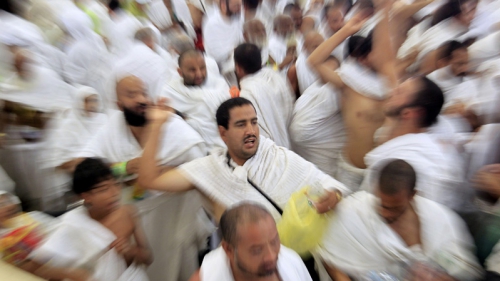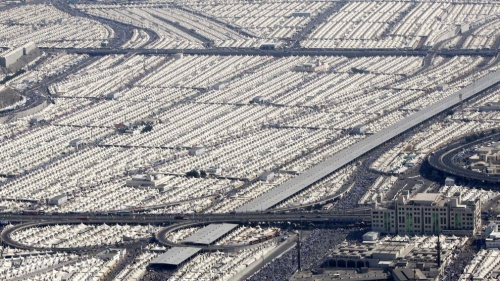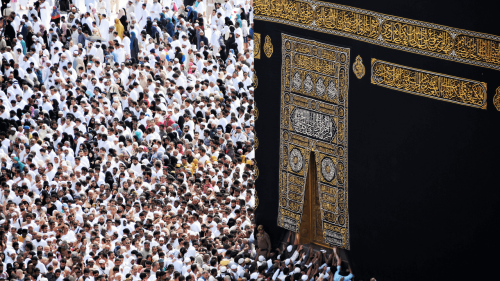One Pilgrim's Story of a Journey for Millions

This week, millions of our Muslim neighbors are completing the pilgrimage to Mecca. Unfortunately, because of the implosion of American news media and the dwindling numbers of religion writers, there is very little coverage of the Hajj in U.S. news media this week.
Our pioneering approach at ReadTheSpirit is to blend traditional journalistic approaches in writing about religion and spiritual media — with an international network of readers and writers who lend their own voices and stories to enrich all of us.
So, we can’t think of a better way to honor the pilgrims this week and to give you a taste of the Hajj than to share this “Letter from the Hajj,” written by Victor Begg, who is based in Michigan but is known nationally in interfaith networks as a Muslim peace activist.
This isn’t a text-book entry. It’s one pilgrim’s journey among millions. He originally wrote this account for friends and the letter took on a life of its own. It has been the basis for sermons delivered by clergy who received the letter, including one rabbi. Overall, it’s the kind of personal approach we love to take toward important spiritual milestones like the Hajj.
A LETTER FROM THE HAJJ
By Victor Begg

Hajj is one of the 5 pillars of Islam, required to be performed once in a lifetime by able-bodied Muslims who are also financially able. Preparation for Hajj includes asking for forgiveness from friends, relatives and acquaintances for any unresolved offenses we may have caused. Muslims often bid farewell by asking for everyone’s good will and taking care of their obligations before they leave for Hajj.
One of the important aspects of the pilgrimage is making seven circles around the house of worship (Kaba) rebuilt by Prophet Abraham (pbuh). It is said that Kaba originally was built by Adam — the common ancestor of all. It is also said: Angels worship God by circling His throne. Thus the circling of Kaba, which we call tawaf, represents the “primordial form of worship,” even before we were created — like the electrons revolving in an atom or the planets revolving around the sun.
Kaba has a black stone encased in a white silver case as one of the corner stones, at the point we initiate circumventing the Kaba. It is said that Angel Gabriel brought this stone from heaven when Prophet Abraham (pbuh) started to build this House of Worship of One God.
During Hajj, men are mandated to dress in two pieces of un-sewn white cloth, one around their waist and one over their upper body, called “ahram” (similar to what Muslims are buried in upon their passing from this world). Dressed alike, divisions among people disappear as all pilgrims recite the same words in one language. We are praying together in Arabic. In English, it means: “I am here O Lord, the One and Only, Glory to You…”
Malcolm X’s views on race were transformed upon witnessing the sea of humanity echoing the same words, clothed alike. These are the words on our lips from the time we put on the ahram, as we must do that when we get within 40 miles of Mecca (which could mean that we take on the state of ahram often in the plane before it lands).
Here is a Sufi perspective on circling of the Kaba:
Holy Shrine
Outside of time
Dressed in black
Mortal beings
Heartfelt pleadings
Dressed in white
Gold gilded door
White marble floor
Heaven’s own white/black stone
White shrouds abound
Circling round
Chanting prayers
Heavenly dance
Prayers enhanced
Rising up
Focused glance
Prayerful trance
Singing praise
Cries out loud
From the shrouds
Seeking grace
Beloved Lord
You’ve seen and heard
All that we hide
Accept our plea
Set the guilty free
Saved from the fire
Attachment lost
Illusions crossed
Subhan Allah (All glory to God)
All praises to Him
Without kin
Alone and One
Ya Rahman Ya Rahim
Ya Rahman Ya Rahim
Ih-dinus-sirat-ul-mustaqeem
(O Most Merciful One
O Most Compassionate One
Show us the straight path)

After the tawaf, we drink from the well of zam zam that was created instantly by the will of God, according to our teachings, by Archangel Gabriel, to quench the thirst of Abraham’s first born, left in the desert by father Abraham with his mother, Hagar. Water provided sustenance for baby Ishmael in answer to Hagar’s prayers. I saw millions of pilgrims drink from the well and wash their faces, hands and feet in ablution. I was amazed how this water flows freely.
We then pray at the spot where footsteps of Abraham (pbuh) are preserved. Next, we retrace the steps of Hagar running between the two hills called Safa and Marwa, looking for water or some caravan to help her newborn baby, Ishmael.
In the next few days, there are other rites we must perform. Millions of people move after the morning prayers on the 8th day of the lunar month Zul-Hijjah towards the plains of Arafa and spend the night in the tent city of Mina along the way, just as the Prophet (pbuh) did more than 1,400 years ago. Next day, in Arafa, we gather where the Prophet (pbuh) gave his final sermon from a hill top. Muslims believe that the gathering in Arafa, clothed in white shrouds (no restriction for women but most cover themselves in white or plain color), represents the assembly of the resurrected humanity on the Day of Judgment. We pray more for forgiveness and for God’s blessings.

I prayed to God to grant me forgiveness and for my family, friends, and our communities and for peace in the world.
Then the millions move again from the plains of Arafa to an area called Muzdalfa for night prayers where Prophet Muhammad (pbuh) spent the night. We pick up pebbles from the desert to demolish the Satan who tried to mislead Ishmael (pbuh) and Abraham (pbuh) on three different occasions. So, the next day, armed with those pebbles, we return to Mina to perform the rites (you know all about the throwing of these pebbles, thanks to CNN) and we live in the tent city spending the next 2 nights — praying and meditating and discarding the evil (Satan).
Next, we return to Mecca to do our farewell tawaf. Men will shave their heads. Yes, including me as we are supposed to be newly born free of all sins upon proper completion of the pilgrimage. At the end of the pilgrimage, we sacrifice a lamb in commemoration of the sacrifice made by our great-grandpa Abraham (pbuh), in quest for submitting unconditionally to God’s will.
Prophet Abraham (pbuh) also prayed to God to bless this area with a city and the fruits to eat. We witnessed the bustling humanity, abundance of the fruits and goods from all over the world in the city of Mecca. God answered his prayers and continues to bless the desert city to this day. We pray, we meditate, we shop, we taste the international cuisine, we catch a few holy germs (I was still coughing upon arriving back at my home airport) but overall it is a great soul-satisfying experience. My wife absolutely lost herself in it.
We had a large American contingent plus Canadian, European, Asian and African brothers and sisters who traveled with us. During Hajj, millions of people move from site to site over a period of days, which also makes one a very patient person.
In spite of occasional mishaps, during this enormous gathering of pilgrims, Hajj is God’s miracle in itself.
( Reprinted from ReadTheSpirit )

















